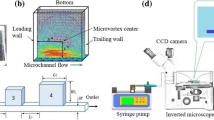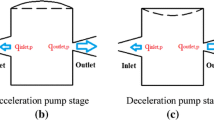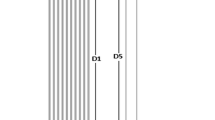Abstract
This paper investigates the unsteady characteristics of flow in a specific type of microvalve with sudden expansion shape. The resultant vortex structures cause different flow resistance in forward and backward flow directions. This may be used in applications such as a microvalve in micropump system and MEMS-based devices. A time-varying sinusoidal pressure was set at the inlet of the microchannel to produce unsteadiness and simulate the pumping action. The existence of block obstacle and expansion shoulders leads to various sizes of vortex structures in each flow direction. All simulation results are based on the numerical simulation of two-dimensional, unsteady, incompressible and laminar Navier–Stokes equations. Two fundamental parameters were varied to investigate the vortex growth throughout the time: the frequency of the inlet actuating mechanism (1 Hz ≤ f ≤ 1,000 Hz) and the amplitude of the inlet pressure. In this way, one can see the effect of actuation mechanism on the onset of separation and follow the size and duration of the vortex growth. In order to better understand the effect of geometry and frequency on flow field, the pressure and velocity distributions are studied through one cycle. Strouhal number is calculated for frequency, and a critical value of f = 250 Hz is found for St = 1. The obtained results provide a deep insight into the physics of unsteady flow in valveless micropumps and leads to better use of current design as a part of microfluidic system.

















Similar content being viewed by others
References
Amirouche F, Zhou Y, Johnson T (2009) Current micropump technologies and their biomedical applications. Microsyst Technol 15:647–666
Au AK, Lai H, Utela BR, Folch A (2011) Microvalves and micropumps for biomems. Micromachines 2:179–220
Boustheen A, Homburg FGA, Dietzel A (2012) A modular microvalve suitable for lab on a foil: manufacturing and assembly concepts. Microelectron Eng 98:638–641
Chang CL, Leong JC, Hong TF, Wang YN, Fu LM (2011) Experimental and numerical analysis of high-resolution injection technique for capillary electrophoresis microchip. Int J Mol Sci 12:3594–3605
Chung YC, Hsu YL, Jen CP, Lu MC, Lin YC (2004) Design of passive mixers utilizing microfluidic self-circulation in the mixing chamber. Lab Chip 4(1):70–77
Cohen JL, Westly DA, Pechenik A, Abruna HD (2005) Fabrication and preliminary testing of a planar membraneless microchannel fuel cell. J Power Sour 139:96–105
Du X, Zhang P, Liu Y, Wu Y (2011) A passive through hole microvalve for capillary flow control in microfluidic systems. Sens Actuators A Phys 165:288–293
Forster FK, Bardell RL (1995) Design, fabrication and testing of fixed-valve micropumps. ASME 234:277–286
Lee DE, Soper S, Wang WJ (2008) Design and fabrication of an electrochemically actuated microvalve. Microsyst Technol 14:1751–1756
Lin CH, Wang YN, Fu LM (2012) Integrated microfluidic chip for rapid DNA digestion and time-resolved capillary electrophoresis analysis. Biomicrofluidics 6:012818
Liou D, Hsieh Y, Kuo L, Yang C, Chen P (2011) Modular component design for portable microfluidic design. Microfluid Nanofluid 10:465–474
Loverich J, Kanno I, Kotera H (2007) Single-step replicable microfluidic check valve for rectifying and sensing low Reynolds number flow. Microfluid Nanofluid 3:427–435
Movahed S, Li D (2011) Microfluidics cell electroporation. Microfluid Nanofluid 10:703–734
Nabavi M (2009) Steady and unsteady flow analysis in microdiffusers and micropumps: a critical review. Microfluid Nanofluid 7:599–619
Nabavi M, Mongeau L (2009) Numerical analysis of high frequency pulsating flows through a diffuser-nozzle element in valveless acoustic micropumps. Microfluid Nanofluid 7:669–681
Sheen H, Hsu C, Wu T, Chang C, Chu H, Yang C, Lei U (2008) Unsteady flow behaviors in an obstacle-type valveless micropump by micro-PIV. Microfluid Nanofluid 4:331–342
Stemme E, Stemme G (1993) A valveless diffuser/nozzle-based fluid pump. Sens Actuators A Phys 39:159–167
Sun C, Huang K (2006) Numerical characterization of the flow rectification of dynamic microdiffusers. J Micromech Microeng 16:1331–1339
Sun H, Nie Z, Fung YS (2010) Determination of free bilirubin and its binding capacity by HSA using a microfluidic chip-capillary electrophoresis device with a multi-segment circular-ferrofluid-driven micromixing injection. Electrophoresis 31:3061–3069
Thompson SM, Ma HB, Wilson C (2011) Investigation of a flat-plate oscillating heat pipe with Tesla-type check valves. Exp Therm Fluid Sci 35:1265–1273
Truong TQ, Nguyen NT (2003) Simulation and optimization of tesla valves. Nanotech 1:178––181
Tsai CH, Chen HT, Wang YN, Lin CH, Fu LM (2007) Capabilities and limitations of 2-dimensional and 3-dimensional numerical methods in modeling the fluid flow in sudden expansion microchannels. Microfluid Nanofluid 3:13–18
Tsai CH, Lin CH, Fu LM, Chen HC (2012a) High performance microfluidic rectifier based on the sudden expansion channel with embedded block structure. Biomicrofluidics 6:024108
Tsai CH, Yeh CH, Lin CH, Yang RJ, Fu LM (2012b) Formation of recirculation zones in a sudden expansion microchannel with a rectangular block structure over a wide Reynolds number range. Microfluid Nanofluid 12:213–220
Van De Pol FCM (1989) A pump based on micro-engineering techniques. University of Twente, Enschede
Wang K, Yue S, Wang L, Jin A, Gu C, Wang P, Feng Y, Wang Y, Niu H (2006) Manipulating DNA molecules in nanofluidic channels. Microfluid Nanofluid 2:85–88
Wang C, Leu T, Sun J (2007) Unsteady analysis of microvalves with no moving parts. J Mech 23:9–14
Yang KS, Chen IY, Wang CC (2006) Performance of nozzle/diffuser micro-pumps subject to parallel and series combinations. Chem Eng Technol 29:703–710
Yang KS, Chen IY, Chien KH, Wang CC (2008) A numerical study of the nozzle/diffuser micropump. Proc Inst Mech Eng C J Mech E 222(3):525–533
Yeh CH, Lin PW, Lin YC (2010) Chitosan microfiber fabrication using a microfluidic chip and its application to cell cultures. Microfluid Nanofluid 8:115–121
Author information
Authors and Affiliations
Corresponding author
Rights and permissions
About this article
Cite this article
Nejat, A., Kowsary, F., Hasanzadeh-Barforoushi, A. et al. Unsteady pulsating characteristics of the fluid flow through a sudden expansion microvalve. Microfluid Nanofluid 17, 623–637 (2014). https://doi.org/10.1007/s10404-014-1343-9
Received:
Accepted:
Published:
Issue Date:
DOI: https://doi.org/10.1007/s10404-014-1343-9




